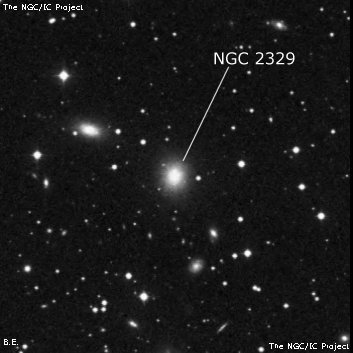
William Herschel discovered NGC 2329 = H II-735 = h429 on 9 Mar 1788 (sweep 815) and called "F, stellar." His position is 3' east of UGC 3695, the brightest galaxy in AGC 569. He observed the field again on 28 Dec 1790 (sweep 990) and picked up two galaxies -- NGC 2329 and UGC 3696, oriented southwest-northeast (12 sec of time and 2' north). Caroline assumed the southwest object was new and assigned it III-875. She thought the northeast object was II-735, so it didn't receive a new designation. John Herschel only saw a single galaxy and equated H. II-735 = H. III-875 in the General Catalogue. Dreyer assigned both designations to NGC 2329. Since WH clearly observed both galaxies on 28 Dec 1790, Wolfgang Steinicke concludes III-875 should refer to UGC 3696, a galaxy that should have received a NGC designation.
Although usually classified as a Lenticular Galaxy, recent studies have concluded NGC 2329 is a 'cluster dominant' Elliptical Galaxy (cD). It is an x-ray source with a radio jet streaming from its core, like many other cD's. In addition that is also a 'radio tail' extending from this galaxy.
400/500mm - 17.5" (1/19/91): fairly faint, fairly small, slightly elongated, bright core. A mag 15 star is 0.7' W of center. Three mag 14 stars lie 1.7' W, 1.3' NE and 2.0' NE. Forms a pair with UGC 3696 3' ENE. Brightest member of AGC 569.
Notes by Steve Gottlieb